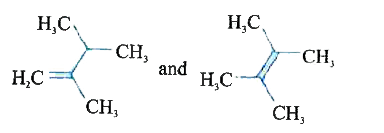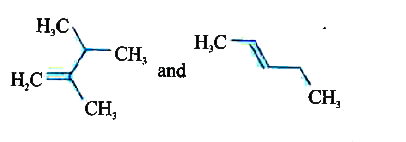An alkyl halide of formula C4H9Cl on treatment with alcoholic potash gives alkenes C4H8. Both alkenes on treatment with HI give 2-iodobutane. Isomeric alkenes are
CH3CH2CH=CH2andCH3CH=CHCH3
CH3CH2CH=CH2and(CH3)2C=CH2
CH3CH=CH2andCH3CH=CHCH3
CH3CH2CH=CH2andCH3CH=CH2
The correct Answer is:A
Topper's Solved these Questions
- HALOALKANES AND HALOARENES BOOK - MTG GUIDECHAPTER - HALOALKANES AND HALOARENES EXERCISE - AIMPT/NEET
10 Videos
- HALOALKANES AND HALOARENES BOOK - MTG GUIDECHAPTER - HALOALKANES AND HALOARENES EXERCISE - NEET CAFE TOPICWISE PRACTICE QUESTIONS
93 Videos
- GENERAL PRINCIPALS AND PROCESSES OF ISOLATION OF ELEMENTSBOOK - MTG GUIDECHAPTER - GENERAL PRINCIPALS AND PROCESSES OF ISOLATION OF ELEMENTSEXERCISE - AIPMT/NEET (MCQs)
10 Videos
- ORGANIC COMPOUNDS CONTAINING NITROGENBOOK - MTG GUIDECHAPTER - ORGANIC COMPOUNDS CONTAINING NITROGENEXERCISE - AIPMT/NEET MCQs
21 Videos
Similar Questions
An alkyl halide (X)of the folmula C6H13Cl on treatment with potassium tertiary butoxide gives two isomeric alkenes (Y) and (Z)(C6H12). Both the alkenes on hydrogenation give 2,3−dimethyl butane. Perdict the structures of (X),(Y) , and (Z)
View SolutionAn alkyl halide (X)of the folmula C6H13Cl on treatment with potassium tertiary butoxide gives two isomeric alkenes (Y) and (Z)(C6H12). Both the alkenes on hydrogenation give 2,3−dimethyl butane. Perdict the structures of (X),(Y) , and (Z)
View Solution
Knowledge Check
An alkyl halide of formula C4H9Cl on treatement with alcoholic potash gives alkenes C4H8. Both alkenes on tratment with HI gives 2-iodo butate. Isomeric alkenes are
ACH3CH2CH=CH2andCH3CH=CHCH3BCH3CH2=CH2and(CH3)2C=CH2CCH3CH=CH2andCH3CH=CHCH3DCH3CH2CH=CH2andCH3CH=CH2An alkyl halide of formula C6CH13Cl on treatment with potassium t-butoxide gives two isomeric alkenes (C6H12). Both alkenes on hydrogenation give 2,2-dimethylbutane. Isomeric alkenes are
ACH2=C∣CH3−C∣CH3H−CH3andCH3−C∣CH2=C∣CH3−CH3BCH2=C∣CH3−C∣CH3H−CH3andCH3−CH=CH−CH2CH3CCH3−CH=CH−CH2CH3and(CH3)2C=(CH3)2DCH2=C∣CH3−C∣CH3H−CH3andCH2=C∣CH3−CH2−CH2−CH3An alkyl halide of formula C6H13CI on treatment with potassium t-butoxide given two isomeric alkanes (C6H12) . Both alkenes on hydrogenation give 2,3 dimethyl butane. Isomeric alkanes are
A B
B C
C D
D
An alkyl halide (X)of the folmula C6H13Cl on treatment with potassium tertiary butoxide gives two isomeric alkenes (Y) and (Z)(C6H12). Both the alkenes on hydrogenation give 2,3−dimethyl butane. Perdict the structures of (X),(Y) , and (Z)
View SolutionAn alkyl halide (X)of the folmula C6H13Cl on treatment with potassium tertiary butoxide gives two isomeric alkenes (Y) and (Z)(C6H12). Both the alkenes on hydrogenation give 2,3−dimethyl butane. Perdict the structures of (X),(Y) , and (Z)
View SolutionAn alkyl halide (A) of formula C6H11Cl on treatement with potassium tertiary butoxie gives two isomeric alkenes (B) and (C) C6H10. Both alkene on hydrogenation give methycyclopentane. Predict the structure of (A), (B) and (C).
View SolutionAn alkyl halide of formula C6H13Br on treatment with potassium t-butoxide gives two isomeric alkenes dimethy butane. Isomeric alkene are :
View SolutionAn alkyl halide of formula C6H13Br on treatment with potassium t-butoxide gives two isomeric alkenes dimethy butane. Isomeric alkene are :
View Solution
